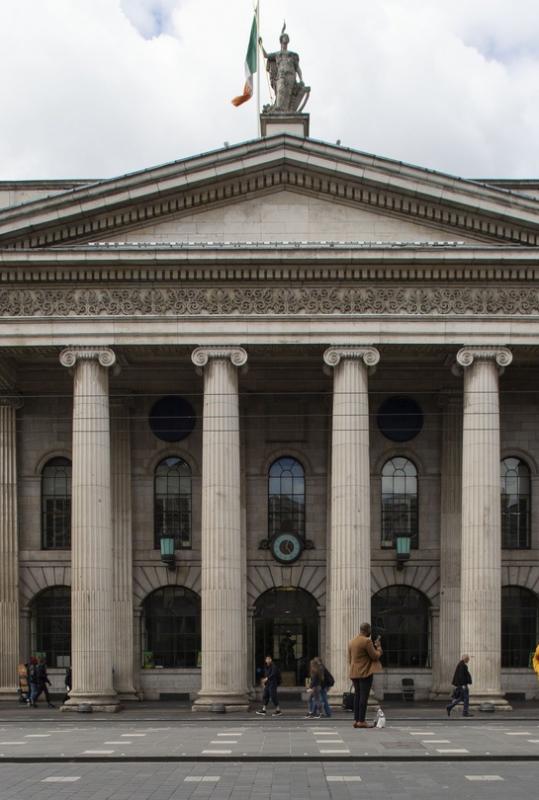The tour begins outside the General Post Office (GPO) on O’Connell Street not far from the unmissable Spire on Dublin’s main street. It is a distinguished building recognizable by the portico comprising six iconic granite columns, some of which still bear the scars of the Rising with bullet holes in the stonework. Inside the GPO is a museum dedicated to the role of the building in 1916 Rising.
1. GPO
Stories
Directions
On the eve of insurrection
‘England’s difficulty is Ireland’s opportunity’ was the dominant principle that was embraced by the Irish Republican Brotherhood (IRB), which formed the IRB Military Council in 1915. The IRB, with the authority of the ‘Provisional Government’ of the Irish Republic, created the Proclamation of Independence against the British Rule and Home Rule. They soon joined forces with the Irish Volunteer Force (IVF) and gained a considerable number of men willing to fight in the upcoming uprising. With the outburst of WWI, most of these men enlisted in the British army to fight the Triple Alliance. Of 180,000 men only 11,000 were left behind, mainly those strongly opposed to the war. Eoin MacNeill (1867 – 1945), who was among the IVF leaders, rejected proposals for an uprising during the War but the remaining signatories thought it was an unmissable opportunity. The date of the rising was set on Easter Sunday, the 23rd of April 1916. But just before the eve of the rising, plans were threatened by a leak of information, and the capture of a ship transferring German weapons to Ireland. Nevertheless, they made the decision to proceed on the 24 April with what is now known as the Easter Rising.
Α sovereign independent Republic
The Proclamation of Independence was an indisputable symbol of unity and collaboration among the Irish Republican Brotherhood, the Irish Volunteers, and the Irish Citizen Army. The Proclamation declared the independence of Ireland and the indefeasible right of Irish people to self - government. It stated that the Irish Republic would safeguard all citizens’ religious and civil freedoms as well as equality between men and women while ensuring their right for happiness and prosperity. The Proclamation highlighted the Irish peoples’ armed fights and struggles spanning across a 300-year period to reach Ireland’s national freedom. It was signed by the members of the Provisional Government: Thomas J. Clarke (1858–1916), Sean Mac Diarmada (1883–1916), Thomas MacDonagh (1878–1916)), P. H. Pearse (1879–1916), Eamonn Ceannt (1881–1916), James Connolly (1868–1916, a revolutionary socialist, trade union leader and political theorist), Joseph Plunkett (1887–1916).
The dawning of a new era
The General Post Office (established 1818), was selected by the Irish rebels as their headquarters for two reasons: its central location, easily seen within a wide expanse of the city center; and its role as a communication hub able to spread the message of independence throughout the country. On Monday 24, 1916 the rebels seized the GPO building and ordered everyone out. The rebel leader Patrick Pearse then read the Proclamation of Independence on the GPO’s portico. Parallel attacks and gunshots were taking place all over the city. The British troops responded quickly by sending their forces to suppress the uprising. During that week in Dublin, numerous buildings were damaged by British shelling and bombs, lootings, fights, and attacks while the GPO was almost destroyed after being shelled. The burst of fire forced the rebels to abandon it; their poor equipment could not hold against the British military. The resistance gave up on the 29th of April, while the British government recognized the massive destruction caused by artillery fire and the exchequer had to pay a substantial fine. The prime minister offered his assurance for reparations on May 10th, in the House of Commons.
Answer this!
What was the Proclamation of Independence?
Powered by Clio Muse Tours
